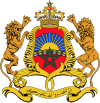Almoravid dynasty
Almoravid dynasty المرابطون, Al-Murābiṭūn | |||||||||||||||
|---|---|---|---|---|---|---|---|---|---|---|---|---|---|---|---|
| 1040–1147 | |||||||||||||||
 Flag | |||||||||||||||
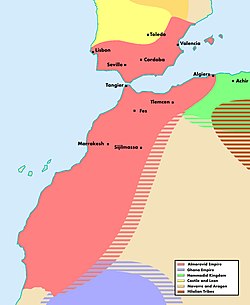 The Almoravid empire at its greatest extent, c. 1120. | |||||||||||||||
| Capital | |||||||||||||||
| Common languages | Berber languages, Arabic, Mozarabic | ||||||||||||||
| Religion | Islam (Sunni); minority Christianity (Roman Catholic), Judaism | ||||||||||||||
| Government | Hereditary monarchy | ||||||||||||||
| Emir | |||||||||||||||
• 1040–1059 | Abdallah ibn Yasin | ||||||||||||||
• 1146–1147 | Ishaq ibn Ali | ||||||||||||||
| History | |||||||||||||||
• Established | 1040 | ||||||||||||||
• Disestablished | 1147 | ||||||||||||||
| Area | |||||||||||||||
| 1120 est.[6] | 1,000,000 km2 (390,000 sq mi) | ||||||||||||||
| Currency | Almoravid Dinar | ||||||||||||||
| |||||||||||||||
| History of Morocco |
|---|
 |
|
|
| History of Mauritania |
|---|
 |
|
|
|
The Almoravid dynasty (Arabic: المرابطون, romanized: Al-Murābiṭūn, lit. 'those from the ribats'[7]) was an imperial Berber Muslim dynasty centered in Morocco.[8][9] It established an empire in the 11th century that stretched over the western Maghreb and Al-Andalus. Founded by Abdallah ibn Yasin, the Almoravid capital was Marrakesh, a city the ruling house founded in 1062. The dynasty originated among the Lamtuna and the Gudala, nomadic Berber tribes of the Western Sahara, traversing the territory between the Draa, the Niger, and the Senegal rivers.[10][11]
The Almoravids were crucial in preventing the fall of Al-Andalus to the Iberian Christian kingdoms, when they decisively defeated a coalition of the Castilian and Aragonese armies at the Battle of Sagrajas in 1086. This enabled them to control an empire that stretched 3,000 kilometers (1,900 mi) north to south. Their rulers never claimed the title of caliph and instead took on the title of Amir al-Muslimīn ("Prince of the Muslims") while formally acknowledging the overlordship of the Abbasid Caliphs in Baghdad.[12] However, the rule of the dynasty was relatively short-lived. The Almoravids fell—at the height of their power—when they failed to stop the Masmuda-led rebellion initiated by Ibn Tumart. As a result, their last king Ishaq ibn Ali was killed in Marrakesh in April 1147 by the Almohad Caliphate, which replaced them as a ruling dynasty both in Morocco and Al-Andalus.
Name[]
The term "Almoravid" comes from the Arabic "al-Murabit" (المرابط), through the Spanish: almorávide.[13] The transformation of the b in "al-Murabit" to the v in almorávide is an example of betacism in Spanish.
In Arabic, "al-Murabit" literally means "one who is tying" but figuratively means "one who is ready for battle at a fortress". The term is related to the notion of ribat رِباط, a North African frontier monastery-fortress, through the root r-b-t (ربط "rabat": to tie , to unite or رابط "raabat": to encamp).[14][15]
The name "Almoravid" was tied to a school of Malikite law called "Dar al-Murabitin" founded in Sus al-Aksa, modern day Morocco, by a scholar named Waggag Ibn Zallu. Ibn Zallu sent his student Abdallah ibn Yasin to preach Malikite Islam to the Sanhaja Berbers of the Sous and Adrar (present-day Mauritania). Hence, the name of the Almoravids comes from the followers of the Dar al-Murabitin, "the house of those who were bound together in the cause of God."[16]
It is uncertain exactly when or why the Almoravids acquired that appellation. al-Bakri, writing in 1068, before their apex, already calls them the al-Murabitun, but does not clarify the reasons for it. Writing three centuries later, Ibn Abi Zar suggested it was chosen early on by Abdallah ibn Yasin[17] because, upon finding resistance among the Gudala Berbers of Adrar (Mauritania) to his teaching, he took a handful of followers to erect a makeshift ribat (monastery-fortress) on an offshore island (possibly Tidra island, in the Bay of Arguin).[18] Ibn Idhari wrote that the name was suggested by Ibn Yasin in the "persevering in the fight" sense, to boost morale after a particularly hard-fought battle in the Draa valley c. 1054, in which they had taken many losses. Whichever explanation is true, it seems certain the appellation was chosen by the Almoravids for themselves, partly with the conscious goal of forestalling any tribal or ethnic identifications.
The name might be related to the ribat of Waggag ibn Zallu in the village of Aglu (near present-day Tiznit), where the future Almoravid spiritual leader Abdallah ibn Yasin got his initial training. The 13th-century Moroccan biographer Ibn al-Zayyat al-Tadili, and Qadi Ayyad before him in the 12th century, note that Waggag's learning center was called Dar al-Murabitin (The house of the Almoravids), and that might have inspired Ibn Yasin's choice of name for the movement.[19][20]
Contemporaries frequently referred to them as the al-mulathimun ("the veiled ones", from litham, Arabic for "veil"). The Almoravids veiled themselves below the eyes with a tagelmust, a custom they adapted from southern Sanhaja Berbers. (This can still be seen among the modern Tuareg people, but it was unusual further north.) Although practical for the desert dust, the Almoravids insisted on wearing the veil everywhere, as a badge of "foreignness" in urban settings, partly as a way of emphasizing their puritan credentials. It served as the uniform of the Almoravids. Under their rule, sumptuary laws forbade anybody else from wearing the veil, thereby making it the distinctive dress of the ruling class. In turn, the succeeding Almohads made a point of mocking the Almoravid veil as symbolic of effeminacy and decadence.
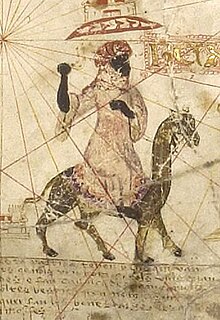
History[]
Origins[]
The Berbers of the Maghreb in the early Middle Ages could be roughly classified into three major groups: the Zenata across the north, the Masmuda, concentrated in central Morocco, and the Sanhaja, clustered in the western part of the Sahara and the hills of the eastern Maghreb.[21][22] The eastern Sanhaja included the Kutama Berbers, who had been the base of the Fatimid rise in the early 10th century, and the Zirid dynasty, who ruled Ifriqiya as vassals of the Fatimids after the latter moved to Egypt in 972. The western Sanhaja were divided into several tribes: the Gazzula and the Lamta in the Draa valley and the foothills of the Anti-Atlas range; further south, encamped in the western Sahara, were the Massufa, the Lamtuna and the Banu Warith; and most southerly of all, the Gudala, in littoral Mauritania down to the borderlands of the Senegal River.
The western Sanhaja had been converted to Islam some time in the 9th century. They were subsequently united in the 10th century and, with the zeal of new converts, launched several campaigns against the "Sudanese" (pagan peoples of sub-Saharan Africa).[23] Under their king Tinbarutan ibn Usfayshar, the Sanhaja Lamtuna erected (or captured) the citadel of Awdaghust, a critical stop on the trans-Saharan trade route. After the collapse of the Sanhaja union, Awdagust passed over to the Ghana empire; and the trans-Saharan routes were taken over by the Zenata Maghrawa of Sijilmassa. The Maghrawa also exploited this disunion to dislodge the Sanhaja Gazzula and Lamta out of their pasturelands in the Sous and Draa valleys. Around 1035, the Lamtuna chieftain Abu Abdallah Muhammad ibn Tifat (alias Tarsina), tried to reunite the Sanhaja desert tribes, but his reign lasted less than three years.
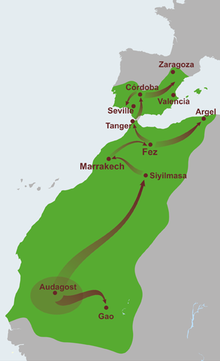
Around 1040, Yahya ibn Ibrahim, a chieftain of the Gudala (and brother-in-law of the late Tarsina), went on pilgrimage to Mecca. On his return, he stopped by Kairouan in Ifriqiya, where he met Abu Imran al-Fasi, a native of Fes and a jurist and scholar of the Sunni Maliki school. At this time, Ifriqiya was in ferment. The Zirid ruler, al-Muizz ibn Badis, was openly contemplating breaking with his Shi'ite Fatimid overlords in Cairo, and the jurists of Kairouan were agitating for him to do so. Within this heady atmosphere, Yahya and Abu Imran fell into conversation on the state of the faith in their western homelands, and Yahya expressed his disappointment at the lack of religious education and negligence of Islamic law among his southern Sanhaja people. With Abu Imran's recommendation, Yahya ibn Ibrahim made his way to the ribat of Waggag ibn Zelu in the Sous valley of southern Morocco, to seek out a Maliki teacher for his people. Waggag assigned him one of his residents, Abdallah ibn Yasin.
Abdallah ibn Yasin was a Gazzula Berber, and probably a convert rather than a born Muslim. His name can be read as "son of Ya Sin" (the title of the 36th Sura of the Qur'an), suggesting he had obliterated his family past and was "re-born" of the Holy Book.[24] Ibn Yasin certainly had the ardor of a puritan zealot; his creed was mainly characterized by a rigid formalism and a strict adherence to the dictates of the Qur'an, and the Orthodox tradition.[25] (Chroniclers such as al-Bakri allege Ibn Yasin's learning was superficial.) Ibn Yasin's initial meetings with the Gudala people went poorly. As he had more ardor than depth, Ibn Yasin's arguments were disputed by his audience. He responded to questioning with charges of apostasy and handed out harsh punishments for the slightest deviations. The Gudala soon had enough and expelled him almost immediately after the death of his protector, Yahya ibn Ibrahim, sometime in the 1040s.
Ibn Yasin, however, found a more favorable reception among the neighboring Lamtuna people.[25] Probably sensing the useful organizing power of Ibn Yasin's pious fervor, the Lamtuna chieftain Yahya ibn Umar al-Lamtuni invited the man to preach to his people. The Lamtuna leaders, however, kept Ibn Yasin on a careful leash, forging a more productive partnership between them. Invoking stories of the early life of Muhammad, Ibn Yasin preached that conquest was a necessary addendum to Islamicization, that it was not enough to merely adhere to God's law, but necessary to also destroy opposition to it. In Ibn Yasin's ideology, anything and everything outside of Islamic law could be characterized as "opposition". He identified tribalism, in particular, as an obstacle. He believed it was not enough to urge his audiences to put aside their blood loyalties and ethnic differences, and embrace the equality of all Muslims under the Sacred Law, it was necessary to make them do so. For the Lamtuna leadership, this new ideology dovetailed with their long desire to refound the Sanhaja union and recover their lost dominions. In the early 1050s, the Lamtuna, under the joint leadership of Yahya ibn Umar and Abdallah ibn Yasin—soon calling themselves the al-Murabitin (Almoravids)—set out on a campaign to bring their neighbors over to their cause.
Conquests[]
Northern Africa[]
From 1053, the Almoravids began to spread their religious way to the Berber areas of the Sahara, and to the regions south of the desert. After winning over the Sanhaja Berber tribe, they quickly took control of the entire desert trade route, seizing Sijilmasa at the northern end in 1054, and Aoudaghost at the southern end in 1055. Yahya ibn Umar was killed in a battle in 1057,[26] but Abdullah ibn Yasin, whose influence as a religious teacher was paramount, named his brother Abu Bakr ibn Umar as chief. Under him, the Almoravids soon began to spread their power beyond the desert, and conquered the tribes of the Atlas Mountains. They then came in contact with the Berghouata, a Berber tribal confederation, who followed an Islamic "heresy" preached by Salih ibn Tarif three centuries earlier. The Berghouata resisted. Abdullah ibn Yasin was killed in battle with them in 1059, in Krifla, a village near Rommani, Morocco. They were, however, completely conquered by Abu Bakr ibn Umar, and were forced to convert to orthodox Islam.[27] Abu Bakr married a noble and wealthy Berber woman, Zaynab an-Nafzawiyyat, who would become very influential in the development of the dynasty.[28] Zaynab was the daughter of a wealthy merchant from Houara, who was said to be from Kairouan.[28]
In 1061, Abu Bakr ibn Umar made a division of the power he had established, handing over the more-settled parts to his cousin Yusuf ibn Tashfin as viceroy, and also assigning to him his favourite wife Zaynab. Ibn Umar kept the task of suppressing the revolts that had broken out in the desert. When he returned to resume control, he found his cousin too powerful to be superseded.[27] In November 1087,[29] Abu Bakr was killed in battle – according to oral tradition by an arrow[30][31] - while fighting in the historic region of the Sudan.[29]
Yusuf ibn Tashfin had in the meantime brought the large area of what is now known as Morocco, Western Sahara, and Mauritania into complete subjection. In 1062 he founded the city of Marrakech. In 1080, he conquered the kingdom of Tlemcen (in modern-day Algeria) and founded the present city of that name, his rule extending as far east as Oran.[27]
Ghana Empire and the southern wing[]
According to Arab tradition, the Almoravids conquered the Ghana Empire sometime around 1076 CE.[32] An example of this tradition is the record of historian Ibn Khaldun, who cited Shaykh Uthman, the faqih of Ghana, writing in 1394. According to this source, the Almoravids weakened Ghana and collected tribute from the Sudan, to the extent that the authority of the rulers of Ghana dwindled away, and they were subjugated and absorbed by the Susu, a neighboring people of the Sudan.[33] Traditions in Mali related that the Soso attacked and took over Mali as well, and the ruler of the Soso, Sumaouro Kanté, took over the land.[34]
However criticism from Conrad and Fisher (1982) argued that the notion of any Almoravid military conquest at its core is merely perpetuated folklore, derived from a misinterpretation or naive reliance on Arabic sources.[35] According to Professor Timothy Insoll, the archaeology of ancient Ghana simply does not show the signs of rapid change and destruction that would be associated with any Almoravid-era military conquests.[36]
Dierke Lange agreed with the original military incursion theory but argues that this doesn't preclude Almoravid political agitation, claiming that the main factor of the demise of the Ghana Empire owed much to the latter.[37] According to Lange, Almoravid religious influence was gradual, rather than the result of military action; there the Almoravids gained power by marrying among the nation's nobility. Lange attributes the decline of ancient Ghana to numerous unrelated factors, one of which is likely attributable to internal dynastic struggles instigated by Almoravid influence and Islamic pressures, but devoid of military conquest.[38]
This interpretation of events has been disputed by later scholars like Sheryl L. Burkhalter (1992), who argued that, whatever the nature of the "conquest" in the south of the Sahara, the influence and success of the Almoravid movement in securing west African gold and circulating it widely necessitated a high degree of political control.[39]
The traditional position says that the ensuing war with the Almoravids pushed Ghana over the edge, ending the kingdom's position as a commercial and military power by 1100. It collapsed into tribal groups and chieftaincies, some of which later assimilated into the Almoravids while others founded the Mali Empire.
The Arab geographer Al-Zuhri wrote that the Almoravids ended Ibadism in Tadmekka in 1084 and that Abu Bakr "arrived at the mountain of gold" in the deep south. After the death of Abu Bakr (1087), the confederation of Berber tribes in the Sahara was divided between the descendants of Abu Bakr and his brother Yahya, and would have lost control of Ghana.[40] Sheryl Burkhalter suggests that Abu Bakr's son Yahya was the leader of the Almoravid expedition that conquered Ghana in 1076, and that the Almoravids would have survived the loss of Ghana and the defeat in the Maghreb by the Almohads, and would have ruled the Sahara until the end of the 12th century.[41]
Southern Iberia and the northern wing[]
This section needs additional citations for verification. (November 2011) |
In 1086 Yusuf ibn Tashfin was invited by the Muslim taifa princes of Al-Andalus in the Iberian Peninsula to defend their territories from the encroachment of Alfonso VI, King of León and Castile. In that year, Ibn Tashfin crossed the Strait of Gibraltar to Algeciras, and defeated Castile at the Battle of az-Zallaqah (Battle of Sagrajas). He was prevented from following up his victory by trouble in Africa, which he chose to settle in person.
He returned to Iberia in 1090, avowedly for the purpose of annexing the taifa principalities of Iberia. He was supported by most of the Iberian people, who were discontented with the heavy taxation imposed upon them by their spendthrift rulers.[27] Their religious teachers, as well as others in the east (most notably, al-Ghazali in Persia and al-Turtushi in Egypt, who was himself an Iberian by birth from Tortosa), detested the taifa rulers for their religious indifference. The clerics issued a fatwa (a non-binding legal opinion) that Yusuf was of sound morals and had the religious right to dethrone the rulers, whom he saw as heterodox in their faith. By 1094, Yusuf had annexed most of the major taifas, with the exception of the one at Saragossa. The Almoravids were victorious at the Battle of Consuegra, during which the son of El Cid, Diego Rodríguez, perished. Alfonso, with some Leónese, retreated into the castle of Consuegra, which was besieged for eight days until the Almoravids withdrew to the south.
After friendly correspondence with the caliph at Baghdad, whom he acknowledged as Amir al-Mu'minin ("Commander of the Faithful"), Yusuf ibn Tashfin in 1097 assumed the title of Amir al Muslimin ("Commander of the Muslims"). He died in 1106, when he was reputed to have reached the age of 100. The Almoravid power was at its height at Yusuf's death: the Moorish empire then included all of Northwest Africa as far eastward as Algiers, and all of Iberia south of the Tagus and as far eastward as the mouth of the Ebro, and including the Balearic Islands.[42]
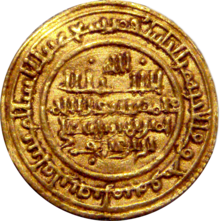
In 1108 Tamim Al Yusuf defeated the Kingdom of Castile at the Battle of Uclés. Yusuf did not reconquer much territory from the Christian kingdoms, except that of Valencia; but he did hinder the progress of the Christian Reconquista by uniting al-Andalus. In 1134 at the Battle of Fraga the Almoravids were victorious and even succeeded in slaying Alfonso I of Aragon in the battle.
Decline[]
This section needs additional citations for verification. (November 2011) |
Under Yusuf's son and successor, Ali ibn Yusuf, Sintra and Santarém were added, and he invaded Iberia again in 1119 and 1121, but the tide had turned, as the French had assisted the Aragonese to recover Zaragoza. In 1138, Ali ibn Yusuf was defeated by Alfonso VII of León, and in the Battle of Ourique (1139), by Afonso I of Portugal, who thereby won his crown. Lisbon was conquered by the Portuguese in 1147.[43]
According to some scholars, Ali ibn Yusuf represented a new generation of leadership that had forgotten the desert life for the comforts of the city.[44] He was defeated by the combined action of his Christian foes in Iberia and the agitation of the Almohads (Muwahhids) in Morocco. After Ali ibn Yusuf's death in 1143, his son Tashfin ibn Ali lost ground rapidly before the Almohads. In 1146 he was killed in a fall from a precipice while attempting to escape after a defeat near Oran.[43]
His two successors were Ibrahim ibn Tashfin and Ishaq ibn Ali, but their reigns were short. The conquest of the city of Marrakech by the Almohads in 1147 marked the fall of the dynasty, though fragments of the Almoravids continued to struggle throughout the empire.[43] Among these fragments, there was the rebel Yahya Al-Sahrāwiyya, who resisted Almohad rule in the Maghrib for eight years after the fall of Marrakech before surrendering in 1155.[45] Also in 1155, the remaining Almoravids were forced to retreat to the Balearic Islands and later Ifriqiya under the leadership of the Banu Ghaniya, who were eventually influential in the downfall of their conquerors, the Almohads, in the Eastern part of the Maghrib.[46]
Culture[]
Religion[]
The Almoravid movement started as a conservative Islamic reform movement inspired by the Maliki school of jurisprudence.[47] The writings of Abu Imran al-Fasi, a Moroccan Maliki scholar, influenced Yahya Ibn Ibrahim and the early Almoravid movement.[48][49]
Art[]
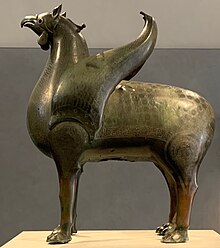
Amira Bennison describes the art of the Almoravid period as influenced by the "integration of several areas into a single political unit and the resultant development of a widespread Andalusi–Maghribi style," as well as the tastes of the Sanhaja rulers as patrons of art.[51] Bennison also challenges Robert Hillenbrand's characterization of the art of al-Andalus and the Maghreb as provincial and peripheral in consideration of Islamic art globally, and of the contributions of the Almoravids as "sparse" as a result of the empire's "puritanical fervour" and "ephemerality."[51]
At first, the Almoravids, subscribing to the conservative Maliki school of Islamic jurisprudence, rejected what they perceived as decadence and a lack of piety among the Iberian Muslims of the Andalusi Ta'ifa kingdoms.[49] However, monuments and textiles from Almería from the late Almoravid period indicate that the empire had changed its attitude with time.[49]
Artistic production under the Almoravids included finely constructed minbars produced in Cordoba; marble basins and tombstones in Almería; fine textiles in Almería, Malaga, Seville; and luxury ceramics.[51]
Marble work[]
A large group of marble tombstones have been preserved from the first half of the 12th century. They were crafted in Almería in Al-Andalus, at a time when it was a prosperous port city under Almoravid control. The tombstones were made of Macael marble, which was quarried locally, and carved with extensive Kufic inscriptions that were sometimes adorned with vegetal or geometric motifs.[53] These demonstrate that the Almoravids not only reused Umayyad marble columns and basins, but also commissioned new works.[51] The inscriptions on them are dedicated to various individuals, both men and women, from a range of different occupations, indicating that such tombstones were relatively affordable. The stones take the form of either rectangular stelae or of long horizontal prisms known as mqabriyyas (similar to the ones found in the much later Saadian Tombs of Marrakesh). They have been found in many locations across West Africa and Western Europe, which is evidence that a wide-reaching industry and trade in marble existed. A number of pieces found in France were likely acquired from later pillaging. Some of the most ornate tombstones found outside Al-Andalus were discovered in Gao-Sané in the African Sahel, testament to the reach of Almoravid influence into the African continent.[51][53]
Two Almoravid-period marble columns have also been found reused as spolia in later monuments in Fes. One is incorporated into the window of the dar al-muwaqqit (timekeeper's house) overlooking the courtyard of the Qarawiyyin Mosque, built in the Marinid period. The other is embedded into the decoration of the exterior southern façade of the Zawiya of Moulay Idris II, a structure which was rebuilt by Moulay Isma'il.[54]
Textiles[]
The fact that Ibn Tumart, leader of the Almohad movement, is recorded as having criticized Sultan Ali ibn Yusuf for "sitting on a luxurious silken cloak" at his grand mosque in Marrakesh indicates the important role of textiles under the Almoravids.[51]

Many of the remaining fabrics from the Almoravid period were reused by Christians, with examples in the reliquary of San Isidoro in León, a chasuble from Saint-Sernin in Toulouse, the Chasuble of San Juan de Ortega in the church of Quintanaortuña (near Burgos), the shroud of San Pedro de Osma, and a fragment found at the church of Thuir in the eastern Pyrenees.[51][55][56][57] Some of these pieces are characterized by the appearance of Kufic or "Hispano-Kufic" woven inscriptions, with letters sometimes ending in ornamental vegetal flourishes. The Chasuble of San Juan de Ortega is one such example, made of silk and gold thread and dating to the first half of the 12th century.[55][56] The Shroud of San Pedro de Osma is notable for its inscription stating "this was made in Baghdad", suggesting that it was imported. However, more recent scholarship has suggested that the textile was instead produced locally in centres such as Almeria, but that they were copied or based on eastern imports.[55] It's even possible that the inscription was knowingly falsified in order to exaggerate its value to potential sellers; Al-Saqati of Malaga, a 12th-century writer and market inspector,[58] wrote that there were regulations designed to prohibit the practice of making such false inscriptions.[55] As a result of the inscription, many of these textiles are known in scholarship as the "Baghdad group", representing a stylistically coherent and artistically rich group of silken textiles seemingly dating to reign of Ali ibn Yusuf or the first half of the 12th century.[55] Aside from the inscription, the shroud of San Pedro de Osma is decorated with images of two lions and harpies inside roundels that are ringed by images of small men holding griffins, repeating across the whole fabric.[55] The chasuble from Saint-Sernin is likewise decorated with figural images, in this case a pair of peacocks repeating in horizontal bands, with vegetal stems separating each pair and small kufic inscriptions running along the bottom.[56]
The decorative theme of having a regular grid of roundels containing images of animals and figures, with more abstract motifs filling the spaces in between, has origins traced as far back as Persian Sassanian textiles. In subsequent periods, starting with the Almohads, these roundels with figurative imagery are progressively replaced with more abstract roundels, while epigraphic decoration becomes more prominent than before.[55]
Calligraphy and manuscript illumination[]
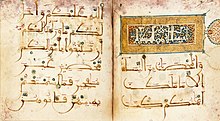
In early Islamic manuscripts, Kufic was the main script used for religious texts. Western or Maghrebi Kufic evolved from the standard (or eastern) Kufic style and was marked by the transformation of the low swooping sections of letters from rectangular forms to long semi-circular forms. It is found in 10th century Qur'ans before the Almoravid period.[59] is the variety of Maghrebi Kufic script that was used as an official display script during the Almoravid period.[60]
Eventually, Maghrebi Kufic gave rise to a distinctive cursive script known as "Maghrebi", the only cursive script of Arabic derived from Kufic, which was fully formed by the early 12th century under the Almoravids.[59] This style was commonly used in Qur'ans and other religious works from this period onward, but it was rarely ever used in architectural inscriptions.[61][59] One version of this script during this early period is the Andalusi script, which was associated with Al-Andalus. It was usually finer and denser, and while the loops of letters below the line are semi-circular, the extensions of letters above the line continue to use straight lines that recall its Kufic origins. Another version of the script is rounder and larger, and is more associated with the Maghreb, although it is nonetheless found in Andalusi volumes too.[59]

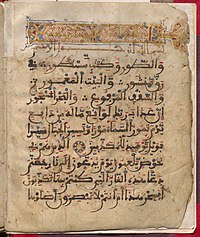
The oldest known illuminated Qur'an from the western Islamic world (i.e. the Maghreb and Al-Andalus) dates from 1090, towards the end of the Taifas period and the beginning of the Almoravid domination in Al-Andalus.[62]:304[61]:224 It was produced either in the Maghreb or Al-Andalus and is now kept at the Uppsala University Library. Its decoration is still in the earliest phases of artistic development, lacking the sophistication of later volumes, but many of the features that were standard in later manuscripts[63] are present: the script is written in the Maghrebi style in black ink, but the diacritics (vowels and other orthographic signs) are in red or blue, simple gold and black roundels mark the end of verses, and headings are written in gold Kufic inside a decorated frame and background.[62]:304 It also contains a frontispiece, of relatively simple design, consisting of a grid of lozenges variously filled with gold vegetal motifs, gold netting, or gold Kufic inscriptions on red or blue backgrounds.[61]:224
More sophisticated illumination is already evident in a copy of a Sahih dated to 1120 (during the reign of Ali ibn Yusuf), also produced in either the Maghreb or Al-Andalus, with a rich frontispiece centered around a large medallion formed by an interlacing geometric motif, filled with gold backgrounds and vegetal motifs.[61]:225 A similarly sophisticated Qur'an, dated to 1143 (at the end of Ali ibn Yusuf's reign) and produced in Cordoba, contains a frontispiece with an interlacing geometric motif forming a panel filled with gold and a knotted blue roundel at the middle.[62]:304
Ceramics[]
The Almoravid conquest of al-Andalus caused a temporary rupture in ceramic production, but it returned in the 12th century.[51] There is a collection of about 2,000 Maghrebi-Andalusi ceramic basins or bowls (bacini) in Pisa, where they were used to decorated churches from the early 11th to fifteenth centuries.[51] There were a number of varieties of ceramics under the Almoravids, including cuerda seca pieces.[51] The most luxurious form was iridescent lustreware, made by applying a metallic glaze to the pieces before a second firing.[51] This technique came from Iraq and flourished in Fatimid Egypt.[51]
Minbars[]
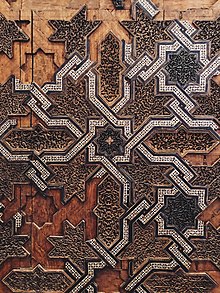
The Almoravid minbars — such as the minbar of the Grand Mosque of Marrakesh commissioned by Sultan Ali ibn Yusuf (1137), or the minbar for the University of al-Qarawiyyin (1144) —[64][49] expressed the Almoravids' Maliki legitimacy, their "inheritance of the Umayyad imperial role," and the extension of that imperial power into the Maghreb.[51] Both minbars are exceptional works of marquetry and woodcarving, decorated with geometric compositions, inlaid materials, and arabesque reliefs.[64][65][66]
Architecture[]
The Almoravid period, along with the subsequent Almohad period, is considered one of the most formative stages of Moroccan and Moorish architecture, establishing many of the forms and motifs of this style that were refined in subsequent centuries.[67][68][69][70] Manuel Casamar Perez remarks that the Almoravids scaled back the Andalusi trend towards heavier and more elaborate decoration which had developed since the Caliphate of Cordoba and instead prioritized a greater balance between proportions and ornamentation.[71]
The two centers of artistic production in the Islamic west before the rise of the Almoravids were the Qayrawan of the Fatimids and the Córdoba of the Umayyads, which served as sources of inspiration.[51] The Almoravids were responsible for establishing a new imperial capital at Marrakesh, which became a major center of architectural patronage thereafter. The Almoravids adopted the architectural developments of al-Andalus, such as the complex interlacing arches of the Great Mosque in Cordoba and of the Aljaferia palace in Zaragoza, while also introducing new ornamental techniques from the east such as muqarnas ("stalactite" or "honeycomb" carvings).[68][72]
After taking control of Al-Andalus in the Battle of Sagrajas, the Almoravids sent Muslim, Christian and Jewish artisans from Iberia to North Africa to work on monuments.[73] The Great Mosque in Algiers (c. 1097), the Great Mosque of Tlemcen (1136) and al-Qarawiyyin (expanded in 1135) in Fes are important examples of Almoravid architecture.[64] The Almoravid Qubba is one of the few Almoravid monuments in Marrakesh surviving, and is notable for its highly ornate interior dome with carved stucco decoration, complex arch shapes, and minor muqarnas cupolas in the corners of the structure.[74]:114 The central nave of the expanded Qarawiyyin Mosque notably features the earliest full-fledged example of muqarnas vaulting in the western Islamic world. The complexity of these muqarnas vaults at such an early date – only several decades after the first simple muqarnas vaults appeared in distant Iraq – has been noted by architectural historians as surprising.[75]:64 Another high point of Almoravid architecture is the intricate ribbed dome in front of the mihrab of the Great Mosque of Tlemcen, which likely traces its origins to the 10th-century ribbed domes of the Great Mosque of Cordoba. The structure of the dome is strictly ornamental, consisting of multiple ribs or intersecting arches forming a twelve-pointed star pattern. It is also partly see-through, allowing some outside light to filter through a screen of pierced and carved arabesque decoration that fills the spaces between the ribs.[76][74]:116–118
Aside from more ornamental religious structures, the Almoravids also built many fortifications, although most of these in turn were demolished or modified by the Almohads and later dynasties. The new capital, Marrakesh, initially had no city walls but a fortress known as the Ksar el-Hajjar ("Fortress of Stone") was built by the city's founder, Abu Bakr ibn Umar, in order to house the treasury and serve as an initial residence.[77][78] Eventually, circa 1126, Ali Ibn Yusuf also constructed a full set of walls, made of rammed earth, around the city in response to the growing threat of the Almohads.[77][78] These walls, although much restored and partly expanded in later centuries, continue to serve as the walls of the medina of Marrakesh today. The medina's main gates were also first built at this time, although many of them have since been significantly modified. Bab Doukkala, one of the western gates, is believed to have best preserved its original Almoravid layout.[79] It has a classic bent entrance configuration, of which variations are found throughout the medieval period of the Maghreb and Al-Andalus.[78][80]:116 Elsewhere, the archaeological site of Tasghimout, southeast of Marrakesh, and Amargu, northeast of Fes, provide evidence about other Almoravid forts. Built out of rubble stone or rammed earth, they illustrate similarities with older Hammadid fortifications, as well as an apparent need to build quickly during times of crisis.[67]:219–220[51]:299–300 The walls of Tlemcen (present-day Algeria) were likewise partly built by the Almoravids, using a mix of rubble stone at the base and rammed earth above.[67]:220
In domestic architecture, none of the Almoravid palaces or residences have survived, and they are known only through texts and archaeology. During his reign, Ali Ibn Yusuf added a large palace and royal residence on the south side of the Ksar el-Hajjar (on the present site of the Kutubiyya Mosque). This palace was later abandoned and its function was replaced by the Almohad Kasbah, but some of its remains have been excavated and studied in the 20th century. These remains have revealed the earliest known example in Morocco of a riad garden (an interior garden symmetrically divided into four parts).[78]:71[67]:404 In 1960 other excavations near Chichaoua revealed the remains of a domestic complex or settlement dating from the Almoravid period or even earlier. It consisted of several houses, two hammams, a water supply system, and possibly a mosque. On the site were found many fragments of architectural decoration which are now preserved at the Archeological Museum of Rabat. These fragments are made of deeply-carved stucco featuring Kufic and cursive Arabic inscriptions as well as vegetal motifs such as palmettes and acanthus leaves.[61]:219–223 The structures were also featured painted decoration in red ochre, typically consisting of border motifs composed of two interlacing bands. Similar decoration has also been found in the remains of former houses excavated in 2006 under the 12th-century Almoravid expansion of the Qarawiyyin Mosque in Fes. In addition to the usual border motifs were larger interlacing geometric motifs as well as Kufic inscriptions with vegetal backgrounds, all executed predominantly in red.[61]:195–197
- Almoravid architecture

The Almoravid Qubba in Marrakesh.

Remains of Bab 'Ali (right), a stone gate built for Ali ibn Yusuf's palace in Marrakesh next to the Ksar el-Hajjar fortress

Bab Doukkala, one of the original gates of Marrakesh constructed circa 1126

Interior of the Great Mosque of Tlemcen

Detail of the Almoravid-era bronze overlays on the doors of al-Qarawiyiin's Bab al-Gna'iz.[65]
Literature[]
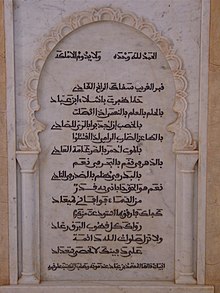
Moroccan literature flourished in the Almoravid period. The political unification of Morocco and al-Andalus under the Almoravid dynasty rapidly accelerated the cultural interchange between the two continents, beginning when Yusuf Bin Tashfiin sent al-Mu'tamid Bin Abbad, former poet king of the Taifa of Seville, into exile in Tangier and ultimately Aghmat.[81]
The historians Ibn Hayyan, Al-Bakri, Ibn Bassam, and al-Fath ibn Khaqan all lived in the Almoravid period.
In the Almoravid period two writers stand out: Ayyad ben Moussa and Ibn Bajja. Ayyad is known for having authored Kitāb al-Shifāʾ bīTaʾrif Ḥuqūq al-Muṣṭafá.[82] Many of the Seven Saints of Marrakesh were men of letters.
The muwashshah was an important form of poetry and music in the Almoravid period. Great poets from the period are mentioned in anthologies such as ,[83] Al Mutrib, and Mu'jam as-Sifr.[84]
The Moroccan historian noted that there were 104 paper mills in Fes under Yusuf Ibn Tashfin in the 11th century.[85]
Military organization[]
Abdallah ibn Yassin imposed very strict disciplinary measures on his forces for every breach of his laws.[86] The Almoravids' first military leader, Yahya ibn Umar al-Lamtuni, gave them a good military organization. Their main force was infantry, armed with javelins in the front ranks and pikes behind, which formed into a phalanx,[87] and was supported by camelmen and horsemen on the flanks.[27][87] They also had a flag carrier at the front who guided the forces behind him; when the flag was upright, the combatants behind would stand and when it was turned down, they would sit.[87]
Al-Bakri reports that, while in combat, the Almoravids did not pursue those who fled in front of them.[87] Their fighting was intense and they did not retreat when disadvantaged by an advancing opposing force; they preferred death over defeat.[87] These characteristics were possibly unusual at the time.[87]
Legends[]
After the death of El Cid, Christian chronicles reported a legend of a Turkish woman leading a band of 300 "Amazons", black female archers. This legend was possibly inspired by the ominous veils on the faces of the warriors and their dark skin colored blue by the indigo of their robes.[88]
Almoravid dynasty[]
Rulers[]
- Abdallah ibn Yasin (1040–1059) – founder & spiritual leader
- Yahya ibn Ibrahim (1048)
- Yahya ibn Umar al-Lamtuni (c. 1050–1056)
- Abu Bakr ibn Umar (1056–1087) – partitioned reign from 1072.
- Yusuf ibn Tashfin (c. 1072–1106)
- Ali ibn Yusuf (1106–43)
- Tashfin ibn Ali (1143–45)
- Ibrahim ibn Tashfin (1145–1147)
- Ishaq ibn Ali (1147)
Family tree[]
| hideAlmoravid family tree | |||||||||||||||||||||||||||||||||||||||||||||||||||||||||||||||||||||||||||||||||||||||||||||||||||||||||||||||||||||||||||||||||||||||||||||||||||||||||||||||||||||||||||||||||||||||||||||||||||||||||||||||||||||||||||||||||||||||||||||||||||||||||||||||||||||||||||||||||||||||||||||||||||||||||||||||||||||||||||||||||||||||||||||||||||||||||||||||||||||||||||||||||||||||||||||||||||||||||||||||||||||||||||||||||||||||||||||||||||||||||||||||||||||||||||||||||||||||||||||||||||||||||||||||||||||||||||||||||||||||||||||||||||||||||||||||||||||||||||||||||||||||||||||||||||||||||||||||||||||||||||||||||||||||||||||||||||||||||||||||||||||||||||||||||||||||||||||||||||||||||||||||||||||||||||||||||||||||||||||||||||||||||||||||||||||||||||||||||||||||||||||||||||||||||||||||||||||||||||||||||||||||||||||||||||||||||||||||||||||||||||||||||||||||||||||||||||||||||||||||||||||||||||||||||||||||||||||||||||||||||||||||||||||||||||||||||||||||||||||||||||||||||||||||||||||||||||||||||||||||
|---|---|---|---|---|---|---|---|---|---|---|---|---|---|---|---|---|---|---|---|---|---|---|---|---|---|---|---|---|---|---|---|---|---|---|---|---|---|---|---|---|---|---|---|---|---|---|---|---|---|---|---|---|---|---|---|---|---|---|---|---|---|---|---|---|---|---|---|---|---|---|---|---|---|---|---|---|---|---|---|---|---|---|---|---|---|---|---|---|---|---|---|---|---|---|---|---|---|---|---|---|---|---|---|---|---|---|---|---|---|---|---|---|---|---|---|---|---|---|---|---|---|---|---|---|---|---|---|---|---|---|---|---|---|---|---|---|---|---|---|---|---|---|---|---|---|---|---|---|---|---|---|---|---|---|---|---|---|---|---|---|---|---|---|---|---|---|---|---|---|---|---|---|---|---|---|---|---|---|---|---|---|---|---|---|---|---|---|---|---|---|---|---|---|---|---|---|---|---|---|---|---|---|---|---|---|---|---|---|---|---|---|---|---|---|---|---|---|---|---|---|---|---|---|---|---|---|---|---|---|---|---|---|---|---|---|---|---|---|---|---|---|---|---|---|---|---|---|---|---|---|---|---|---|---|---|---|---|---|---|---|---|---|---|---|---|---|---|---|---|---|---|---|---|---|---|---|---|---|---|---|---|---|---|---|---|---|---|---|---|---|---|---|---|---|---|---|---|---|---|---|---|---|---|---|---|---|---|---|---|---|---|---|---|---|---|---|---|---|---|---|---|---|---|---|---|---|---|---|---|---|---|---|---|---|---|---|---|---|---|---|---|---|---|---|---|---|---|---|---|---|---|---|---|---|---|---|---|---|---|---|---|---|---|---|---|---|---|---|---|---|---|---|---|---|---|---|---|---|---|---|---|---|---|---|---|---|---|---|---|---|---|---|---|---|---|---|---|---|---|---|---|---|---|---|---|---|---|---|---|---|---|---|---|---|---|---|---|---|---|---|---|---|---|---|---|---|---|---|---|---|---|---|---|---|---|---|---|---|---|---|---|---|---|---|---|---|---|---|---|---|---|---|---|---|---|---|---|---|---|---|---|---|---|---|---|---|---|---|---|---|---|---|---|---|---|---|---|---|---|---|---|---|---|---|---|---|---|---|---|---|---|---|---|---|---|---|---|---|---|---|---|---|---|---|---|---|---|---|---|---|---|---|---|---|---|---|---|---|---|---|---|---|---|---|---|---|---|---|---|---|---|---|---|---|---|---|---|---|---|---|---|---|---|---|---|---|---|---|---|---|---|---|---|---|---|---|---|---|---|---|---|---|---|---|---|---|---|---|---|---|---|---|---|---|---|---|---|---|---|---|---|---|---|---|---|---|---|---|---|---|---|---|---|---|---|---|---|---|---|---|---|---|---|---|---|---|---|---|---|---|---|---|---|---|---|---|---|---|---|---|---|---|---|---|---|---|---|---|---|---|---|---|---|---|---|---|---|---|---|---|---|---|---|---|---|---|---|---|---|---|---|---|---|---|---|---|---|---|---|---|---|---|---|---|---|---|---|---|---|---|---|---|---|---|---|---|---|---|---|---|---|---|---|---|---|---|---|---|---|---|---|---|---|---|---|---|---|---|---|---|---|---|---|---|---|---|---|---|---|---|---|---|---|---|---|---|---|---|---|---|---|---|---|---|---|---|---|---|---|---|---|---|---|---|---|---|---|---|---|---|---|---|---|---|---|---|---|---|---|---|---|---|---|---|---|---|---|---|---|---|---|---|---|---|---|---|---|---|---|---|---|---|---|---|---|---|---|---|---|---|---|---|---|---|---|---|---|---|---|---|---|---|---|---|---|---|---|---|---|---|---|---|---|---|---|---|---|---|---|---|---|---|---|---|---|---|---|---|---|---|---|---|---|---|---|---|---|---|---|---|---|---|---|---|---|---|---|---|---|---|---|---|---|---|---|---|---|---|---|---|---|---|---|---|---|---|---|---|---|---|---|---|---|---|---|---|---|---|---|---|---|---|---|---|---|---|---|---|---|---|---|---|---|---|---|---|---|---|---|---|---|---|---|---|---|---|---|---|---|---|---|---|---|---|---|---|---|---|---|---|---|---|---|---|---|---|---|---|---|---|---|---|---|---|---|---|---|---|---|---|---|---|---|---|---|---|---|---|---|---|---|---|---|---|---|---|---|---|---|---|---|---|---|---|---|---|---|---|---|---|---|---|---|---|---|---|---|---|---|---|---|---|---|---|---|---|---|---|---|---|---|---|---|---|---|---|---|---|---|---|---|---|---|---|---|---|---|---|---|
| |||||||||||||||||||||||||||||||||||||||||||||||||||||||||||||||||||||||||||||||||||||||||||||||||||||||||||||||||||||||||||||||||||||||||||||||||||||||||||||||||||||||||||||||||||||||||||||||||||||||||||||||||||||||||||||||||||||||||||||||||||||||||||||||||||||||||||||||||||||||||||||||||||||||||||||||||||||||||||||||||||||||||||||||||||||||||||||||||||||||||||||||||||||||||||||||||||||||||||||||||||||||||||||||||||||||||||||||||||||||||||||||||||||||||||||||||||||||||||||||||||||||||||||||||||||||||||||||||||||||||||||||||||||||||||||||||||||||||||||||||||||||||||||||||||||||||||||||||||||||||||||||||||||||||||||||||||||||||||||||||||||||||||||||||||||||||||||||||||||||||||||||||||||||||||||||||||||||||||||||||||||||||||||||||||||||||||||||||||||||||||||||||||||||||||||||||||||||||||||||||||||||||||||||||||||||||||||||||||||||||||||||||||||||||||||||||||||||||||||||||||||||||||||||||||||||||||||||||||||||||||||||||||||||||||||||||||||||||||||||||||||||||||||||||||||||||||||||||||||||
Timeline[]

Notes[]
- ^ Arnaud, Jean (21 May 2013). Introduction à la Mauritanie (in French). Institut de recherches et d'études sur le monde arabe et musulman. ISBN 978-2-271-08123-0.
- ^ Nantet, Bernard (30 May 2013). Le Sahara: Histoire, guerres et conquêtes (in French). Tallandier. ISBN 979-10-210-0172-5.
- ^ Gaudio, Attilio (1978). Le Dossier de la Mauritanie (in French). Nouvelles Editions Latines. ISBN 978-2-7233-0035-3.
- ^ Daddah, Mokhtar Ould (1 October 2003). La Mauritanie contre vents et marées (in French). KARTHALA Editions. ISBN 978-2-8111-3765-6.
- ^ Garcin, Jean-Claude; Balivet, Michel; Bianquis, Thierry (1 January 1995). États, sociétés et cultures du monde musulman médiéval : Xe-XVe siècle (1) (in French). Presses universitaires de France (réédition numérique FeniXX). ISBN 978-2-13-067300-2.
- ^ Turchin, Peter; Adams, Jonathan M.; Hall, Thomas D. (December 2006). "East-West Orientation of Historical Empires". Journal of World-systems Research. 12: 222–223. ISSN 1076-156X. Retrieved 1 August 2020..
- ^ Norris, H.T.; Chalmeta, P. (2012). "al-Murābiṭūn". In Bearman, P.; Bianquis, Th.; Bosworth, C.E.; van Donzel, E.; Heinrichs, W.P. (eds.). Encyclopaedia of Islam, Second Edition. Brill.
- ^ G. Stewart, Is the Caliph a Pope?, in: The Muslim World, Volume 21, Issue 2, pages 185–196, April 1931: "The Almoravid dynasty, among the Berbers of North Africa, founded a considerable empire, Morocco being the result of their conquests"
- ^ Sadiqi, Fatima, The place of Berber in Morocco, International Journal of the Sociology of Language, 123.1 (2009): 7–22 : "The Almoravids were the first relatively recent Berber dynasty that ruled Morocco. The leaders of this dynasty came from the Moroccan deep south."
- ^ Meynier, Gilbert (2010). L'Algérie, coeur du Maghreb classique: de l'ouverture islamo-arabe au repli (698-1518) (in French). La Découverte. ISBN 978-2-7071-5231-2.
- ^ Extract from Encyclopedia Universalis on Almoravids.
- ^ Kennedy, Hugh (11 October 2016). Caliphate: The History of an Idea. Basic Books. ISBN 978-0-465-09438-7.
- ^ "Almoravid | Definition of Almoravid by Lexico". Lexico Dictionaries | English. Retrieved 15 October 2019.
- ^ Nehemia Levtzion, "Abd Allah b. Yasin and the Almoravids", in: John Ralph Willis, Studies in West African Islamic History, p. 54.
- ^ P. F. de Moraes Farias, "The Almoravids: Some Questions Concerning the Character of the Movement", Bulletin de l’IFAN, series B, 29: 3–4 (794–878), 1967.
- ^ Messier, Ronald A. The Almoravids and the meanings of jihad, Santa Barbara, CA. Praeger Publishers, 2010.
- ^ Ibn Abi Zar, p. 81.
- ^ Ibn Abi Zar's account is translated in N. Levtzion and J. F. P. Hopkins, eds (2000), Corpus of Early Arabic Sources for West African History, University of Ghana,pp. 239ff. For tentative identification of the ribat, see Moraes Farias (1967).
- ^ Ibn al-Zayyat (1220). التشوف إلى معرفة رجال التصوف [Looking to know the men of Sufism]. p. 89.
- ^ Qadi Ayyad. ترتيب المدارك وتنوير المسالك لمعرفة أعلام مذهب مالك [Biographies of Eminent Maliki Scholars]. pp. 839–40.
- ^ ʻAbd al-Wāḥid Dhannūn Ṭāhā (1998). The Muslim conquest and settlement of North Africa and Spain. Routledge. ISBN 0-415-00474-8. (online at Google Books)
- ^ Mones (1988), p. 119; (1992), p. 228.
- ^ Lewicki (1988), pp. 160–61; (1992), pp. 308–09.
- ^ M. Brett and E. Fentress (1996), The Berbers, Oxford: Blackwell, p. 100. Revealingly, the 36th Sura begins the salutation "You are one of messengers" and the imperative duty to set people "on the straight path". Ibn Yasin's choice of name was probably not a coincidence.
- ^ Jump up to: a b Shillington, Kevin (2005). History of Africa. New York: Palgrave Macmillan. p. 88. ISBN 978-0-333-59957-0.
- ^ Shillington, p. 90.
- ^ Jump up to: a b c d e Chisholm 1911, p. 717.
- ^ Jump up to: a b Ibn Abi Zar, p. 87.
- ^ Jump up to: a b Ibn Abi Zar, p. 89.
- ^ P. Semonin (1964) "The Almoravid Movement in the Western Sudan: A review of the evidence" Transactions of the Historical Society of Ghana, v.7: p.58
- ^ R.A. Messier (2010) The Almoravids and the Meanings of Jihad, Sant Barbar: Praeger. p.209
- ^ Robinson, David. Muslim Societies in African History (New approaches to African History)
- ^ Ibn Khaldun in Levtzion and Hopkins, eds. and transl. Corpus, p. 333.
- ^ Nehemia Levtzion, Ancient Ghana and Mali (New York, 1973), pp. 51–2; 58–60.
- ^ Masonen & Fisher 1996.
- ^ Insoll 2003, p. 230.
- ^ Lange 1996, pp. 122–59.
- ^ Lange, Dierk (1996). "The Almoravid expansion and the downfall of Ghana". Der Islam. 73 (73): 122–159. doi:10.1515/islm.1996.73.2.313. S2CID 162370098..
- ^ Gómez-Rivas, Camilo. Law and the Islamization of Morocco under the Almoravids, p. 13.
- ^ The Cambridge History of Africa, Volume 3: From c.1050 to c.1600
- ^ Burkhalter, Sheryl L. Listening for Silences in Almoravid History: Another Reading of “The Conquest That Never Was"
- ^ Chisholm 1911, pp. 717–718.
- ^ Jump up to: a b c Chisholm 1911, p. 718.
- ^ North Africa, Islam and the Mediterranean World: From the Almoravids to the Algerian War (History & Society in the Islamic World), pg 59 By Julia Ann Clancy-Smith
- ^ Bennison, Amira (2016). The Almorivid and Almohad Empires. Edinburgh University Press Ltd. pp. 61, 342. ISBN 9780748646807.
- ^ K., Bennison, Amira (2016). The Almoravid and Almohad empires. Edinburgh. pp. 91, 270, 342–344. ISBN 9780748646814. OCLC 957145068.
- ^ "Almoravids | Berber confederation". Encyclopedia Britannica. Retrieved 8 June 2020.
- ^ Pellat, Ch. (2004). "Abū ʿImrān al-Fāsī". In Bearman, P.; Bianquis, Th.; Bosworth, C.E.; van Donzel, E.; Heinrichs, W.P. (eds.). Encyclopaedia of Islam. XII (2nd ed.). Leiden, Netherlands: Brill Publishers. p. 27. ISBN 9004139745.
- ^ Jump up to: a b c d Department of Islamic Art. "The Art of the Almoravid and Almohad Periods (ca. 1062–1269)." In Heilbrunn Timeline of Art History. New York: The Metropolitan Museum of Art, 2000–. http://www.metmuseum.org/toah/hd/almo/hd_almo.htm (October 2001)
- ^ BALAFREJ, LAMIA (2012). "Saracen or Pisan?". Ars Orientalis. 42: 31–40. ISSN 0571-1371. JSTOR 43489762.
- ^ Jump up to: a b c d e f g h i j k l m n o Bennison, Amira K. (August 2016). The Almoravid and Almohad empires. Edinburgh. ISBN 978-0-7486-4682-1. OCLC 1003199570.
- ^ Leube, Georg (12 April 2016). "Sacred Topography: A Spatial Approach to the stelae of Gao-Saney". Islamic Africa. 7 (1): 44–59. doi:10.1163/21540993-00701005. ISSN 0803-0685.
- ^ Jump up to: a b Delgado, Jorge Lirola (2014). "Les stèles funéraires d'Almeria, marqueurs du commerce et de la circulation des objets en Méditerranée". In Lintz, Yannick; Déléry, Claire; Tuil Leonetti, Bulle (eds.). Maroc médiéval: Un empire de l'Afrique à l'Espagne. Paris: Louvre éditions. ISBN 9782350314907.
- ^ Salmon, Xavier (2021). Fès mérinide: Une capitale pour les arts, 1276-1465. Lienart. pp. 29–30. ISBN 9782359063356.
- ^ Jump up to: a b c d e f g Partearroyo, Cristina (1992). "Almoravid and Almohad Textiles". In Dodds, Jerrilynn D. (ed.). Al-Andalus: The Art of Islamic Spain. New York: The Metropolitan Museum of Art. pp. 105–113. ISBN 0870996371.
- ^ Jump up to: a b c Lintz, Yannick; Déléry, Claire; Tuil Leonetti, Bulle, eds. (2014). "Au coeur des trésors chrétiens". Maroc médiéval: Un empire de l'Afrique à l'Espagne. Paris: Louvre éditions. ISBN 9782350314907.
- ^ M. Bloom, Jonathan; S. Blair, Sheila, eds. (2009). "Almoravid". The Grove Encyclopedia of Islamic Art and Architecture. Oxford University Press. ISBN 9780195309911.
- ^ LATHAM, J. D. (1 October 1978). "THE INTERPRETATION OF A PASSAGE ON SCALES {MAW ĀZIN) IN AN ANDALUSIAN HISBA MANUAL". Journal of Semitic Studies. 23 (2): 283–290. doi:10.1093/jss/23.2.283. ISSN 0022-4480.
- ^ Jump up to: a b c d Khemir, Sabiha (1992). "The Arts of the Book". In Dodds, Jerrilynn D. (ed.). Al-Andalus: The Art of Islamic Spain. New York: The Metropolitan Museum of Art. ISBN 0870996371.
- ^ معلمة المغرب: قاموس مرتب على حروف الهجاء يحيط بالمعارف المتعلقة بمختلف الجوانب التاريخية و الجغرافية و البشرية و الحضارية للمغرب الاقصى. مطابع سلا،. 1989. p. 6740.
- ^ Jump up to: a b c d e f Lintz, Yannick; Déléry, Claire; Tuil Leonetti, Bulle, eds. (2014). Maroc médiéval: Un empire de l'Afrique à l'Espagne. Paris: Louvre éditions. ISBN 9782350314907.
- ^ Jump up to: a b c Dodds, Jerrilynn D., ed. (1992). Al-Andalus: The Art of Islamic Spain. New York: The Metropolitan Museum of Art. ISBN 0870996371.
- ^ Blair, Sheila S. (2006). Islamic Calligraphy. Edinburgh University Press. pp. 566–569. ISBN 9780748635405.
- ^ Jump up to: a b c Bloom, Jonathan; Toufiq, Ahmed; Carboni, Stefano; Soultanian, Jack; Wilmering, Antoine M.; Minor, Mark D.; Zawacki, Andrew; Hbibi, El Mostafa (1998). The Minbar from the Kutubiyya Mosque. The Metropolitan Museum of Art, New York; Ediciones El Viso, S.A., Madrid; Ministère des Affaires Culturelles, Royaume du Maroc.
- ^ Jump up to: a b Terrasse, Henri (1968). La Mosquée al-Qaraouiyin à Fès; avec une étude de Gaston Deverdun sur les inscriptions historiques de la mosquée. Paris: Librairie C. Klincksieck.
- ^ "Qantara - the minbar of the al-Qarawīyīn Mosque". www.qantara-med.org. Retrieved 21 February 2021.
- ^ Jump up to: a b c d Marçais, Georges (1954). L'architecture musulmane d'Occident. Paris: Arts et métiers graphiques.
- ^ Jump up to: a b Salmon, Xavier (2018). Maroc Almoravide et Almohade: Architecture et décors au temps des conquérants, 1055-1269. Paris: LienArt.
- ^ Bennison, Amira K. (2016). The Almoravid and Almohad Empires. Edinburgh University Press.
- ^ Basset, Henri; Terrasse, Henri (1932). Sanctuaires et forteresses almohades. Paris: Larose.
- ^ Perez, Manuel Casamar (1992). "The Almoravids and Almohads: An introduction". In Dodds, Jerrilynn D. (ed.). Al-Andalus: The Art of Islamic Spain. New York: The Metropolitan Museum of Art. pp. 75–83. ISBN 0870996371.
- ^ Tabbaa, Yasser (2008). "Andalusian roots and Abbasid homage in the Qubbat al-Barudiyyin in Marrakesh". Muqarnas. 25: 133–146. doi:10.1163/22118993_02501006.
- ^ Parker, R. (1981). A Practical Guide to Islamic Monuments in Morocco. Charlottesville, Virginia: Baraka Press. p.14
- ^ Jump up to: a b Bloom, Jonathan M. (2020). Architecture of the Islamic West: North Africa and the Iberian Peninsula, 700-1800. Yale University Press. ISBN 9780300218701.
- ^ Tabbaa, Yasser (1985). "The Muqarnas Dome: Its Origin and Meaning". Muqarnas. 3: 61–74. doi:10.1163/22118993-90000196. JSTOR 1523084.
- ^ Almagro, Antonio (2015). "The Great Mosque of Tlemcen and the Dome of its Maqsura". Al-Qantara. 36 (1): 199–257. doi:10.3989/alqantara.2015.007.
- ^ Jump up to: a b Deverdun, Gaston (1959). Marrakech: Des origines à 1912. Rabat: Éditions Techniques Nord-Africaines.
- ^ Jump up to: a b c d Wilbaux, Quentin (2001). La médina de Marrakech: Formation des espaces urbains d'une ancienne capitale du Maroc. Paris: L'Harmattan. ISBN 2747523888.
- ^ Allain, Charles; Deverdun, Gaston (1957). "Les portes anciennes de Marrakech". Hespéris. 44: 85–126.
- ^ Barrucand, Marianne; Bednorz, Achim (1992). Moorish architecture in Andalusia. Taschen. ISBN 3822876348.
- ^ "دعوة الحق - المعتمد بن عباد في المغرب". habous.gov.ma. Retrieved 5 February 2020.
- ^ ʿA'isha Bint ʿAbdurrahman Bewley, Muhammad Messenger of Allah: ash-Shifa' of Qadi ʿIyad (Granada: Madinah Press, 1992)
- ^ Imad al-Din Muhammad ibn Muhammad Katib al-Isfahani, Kharidat al-qasr wa-jaridat al-asr: Fi dhikr fudala ahl Isfahan (Miras-i maktub)
- ^ cited in: Mohammed Berrada, La Grande Encyclopédie du Maroc, 1987, p. 41
- ^ Sijelmassi, Mohamed (1987). ذخائر مخطوطات الخزانة الملكية بالمغرب: (Bibliothèque al-Hassania) (in French). www.acr-edition.com. ISBN 978-2-86770-025-5.
- ^ al-Bakri, pp. 169–72.
- ^ Jump up to: a b c d e f al-Bakri, p. 166.
- ^ Ronald A. Messier (19 August 2010). The Almoravids and the Meanings of Jihad. ABC-CLIO. p. 118. ISBN 978-0-313-38590-2.
References[]
- Ibn Khaldun, Abderahman (1377). تاريخ ابن خلدون: ديوان المبتدأ و الخبر في تاريخ العرب و البربر و من عاصرهم من ذوي الشأن الأكبر [The history of Ibn Khaldun: Record of the Beginnings and Events in the History of the Arabs and Berbers and their Powerful Contemporaries]. 6. دار الفكر.
- Ibn Abi Zar al-Fassi, Ali Abu al-Hassan (1326). روض القرطاس في أخبار ملوك المغرب و تاريخ مدينة فاس [The Garden of Pages in the Chronicles of the Kings of Morocco and the History of the City of Fes]. Uppsala University.
- al-Bakri (1068). كتاب المسالك و الممالك [Book of the Roads and the Kingdoms]. دار الكتاب الإسلامي, القاهرة.
- Ibn Idhari al-Murakushi, Ahmad (1312). البيان المغرب في أخبار الأندلس والمغرب [Book of the Amazing Story in the Chronicles of the Kings of al-Andalus and Morocco]. جامعة الملك سعود.
- Brett, M. and E. Fentress (1996), The Berbers. Oxford: Blackwell.
- Hrbek, I. and J. Devisse (1988), "The Almoravids", in M. Elfasi, ed., General History of Africa, Africa from the Seventh to the Eleventh Century, UNESCO. 1992 edition, Ch. 13, pp. 336–66.
- Insoll, T (2003). The Archaeology of Islam in Sub-Saharan Africa. Cambridge: Cambridge University Press.
- Lewicki, T. (1988), "The Role of the Sahara and Saharians in relationships between north and south", in M. Elfasi, ed., General History of Africa, Africa from the Seventh to the Eleventh Century, UNESCO. 1992 edition, ch.11, p. 276–313.
- Levtzion, N. and J. F. P. Hopkins, eds (1981), Corpus of Early Arabic Sources for West African History, Cambridge, UK: Cambridge University Press. 2000 edition.
- Messier, R. A. (2010), Almoravids and the Meanings of Jihad, Santa Barbara, Calif.: Praeger.
- Mones, H. (1988), "The conquest of North Africa and Berber resistance", in M. Elfasi, ed., General History of Africa, Africa from the Seventh to the Eleventh Century, UNESCO. 1992 edition, Ch. 9, p. 224-46.
- Moraes Farias, P. F. de (1967), "The Almoravids: Some Questions Concerning the Character of the Movement", Bulletin de l’IFAN, series B, 29:3–4, pp. 794–878.
- This article incorporates text from a publication now in the public domain: Chisholm, Hugh, ed. (1911). "Almoravides". Encyclopædia Britannica. 1 (11th ed.). Cambridge University Press. pp. 717–718.
- Almoravid dynasty
- 11th century in Al-Andalus
- 12th century in Al-Andalus
- Medieval Algeria
- History of Mauritania
- History of Western Sahara
- 11th-century establishments in Africa
- 1147 disestablishments
- 12th-century disestablishments in Morocco
- States and territories established in 1040
- States and territories disestablished in 1147
- Historical transcontinental empires






